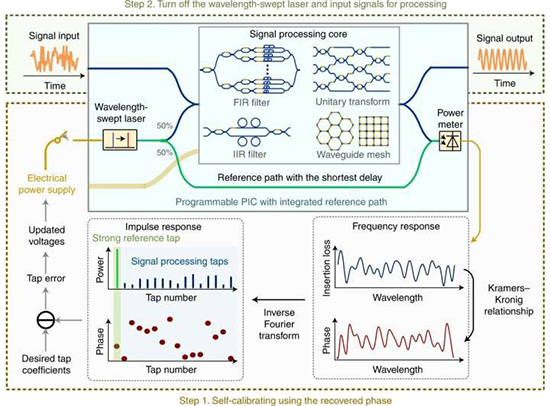Significance
Photonic integrated circuits (PICs) use light rather than electrons to perform a wide variety of optical functions. Recent developments in nanostructures, metamaterials, and silicon technologies have expanded the range of possible functionalities for these highly integrated optical chips. are the driving technology behind next-generation, miniaturised and high performance devices. For example, new internet-reliant technologies like self-driving cars, remote controlled mining and medical equipment will require even faster and increased bandwidth in the future. Bandwidth increase is not just about improving the optical fibers in which our internet travels through, it’s about providing compact switches of many colors, going many directions, so data can be sent down many channels at once.
Photonic integrated circuits are formed by dense discrete integrated optical elements, offer ultra-broad analogue bandwidths that could complement digital electronics and enable throughputs up to tens of petabits per second. Photonic circuits are able to manipulate and route optical channels of information, but they can also provide some computational ability, for example, searching for patterns. Pattern searching is fundamental to many applications: medical diagnosis, autonomous vehicles, internet security, threat identification and search algorithms. Rapid and reliable reprogramming of the chips enables new search tasks to be programmed speedily and accurately. However, this manufacturing needs to be precise to the degree of a tiny wavelength of light (nanometers), which is currently difficult and extremely expensive self-calibration overcomes this problem.
Research led by Monash and RMIT Universities in Australia led by Professor Arthur Lowery has found a way to create an advanced photonic integrated circuit that builds bridges between data superhighways, revolutionizing the connectivity of current optical chips and replacing bulky 3D-optics with a wafer thin slice of silicon. Self-calibration is significant because it makes tunable photonic integrated circuits useful in the real world; applications include optical communications systems that switch signals to destinations based on their color, very fast computations of similarity (correlators), scientific instrumentation for chemical or biological analysis, and even astronomy.
This development, published in the journal Nature Photonics, has the ability to warp-speed the global advancement of artificial intelligence and offers significant real world applications including Safer driverless cars capable of instantly interpreting their surroundings, Enabling AI to more rapidly diagnose medical conditions, Making natural language processing even faster for apps such as Google Homes, Alexa and Siri as well as smaller switches for reconfiguring optical networks that carry our internet to get data where it’s needed faster. Whether it’s turning on a TV or keeping a satellite on course, photonics (the science of light) is transforming the way we live. The photonic chips can transform the processing capability of bulky bench sized utilities onto fingernail sized chips.
The authors have demonstrated a self-calibrating programmable photonic filter chip, featuring a signal processing core and an integrated reference path for self-calibration. The research team previously developed a new optical microcomb chip that can squeeze three times the traffic of the entire NBN through a single optical fiber, regarded as the world’s fastest internet speed from a single fingernail-sized chip. The optical microcomb chip built multiple lanes of the superhighway; now the self-calibrating chip has created the on and off ramps and bridges that connect them all and allow greater movement of data.
A key challenge of the research was integrating all the optical functions onto a device that could be “plugged in” to existing infrastructure. The researchers’ approach was to calibrate the chips after manufacturing, to tune them up in effect by using an on-chip reference, rather than by using external equipment. They added a strong reference path to the developed chip and calibrated it. This gave the authors all the settings required to ‘dial up’ and desired switching function or spectral response. The method is a critical step to make photonic chips practically useful. Rather than searching for a setting, akin to tuning in an old radio, the researchers could tune the chip in one step, enabling the quick and reliable switch of data streams from one destination to another. Reliable tuning of photonic chips opens up many other applications, such as optical correlators, which can almost instantaneously find patterns of data in data streams.
The new photonic technology is now sufficiently advanced so that truly complex systems can be integrated on a single chip. The idea that a device can have an on-chip reference system that allows all its components to work as one is a technological breakthrough that will allow us to address bottleneck internet issues by rapidly reconfiguring the optical networks that carry our internet to get data where it’s needed the most.

Reference
Xingyuan Xu, Guanghui Ren, Tim Feleppa, Xumeng Liu, Andreas Boes, Arnan Mitchell & Arthur Lowery . Self-calibrating programmable photonic integrated circuits. Nature Photonics (2022)
Go To Nature Photonics Advances in Engineering Advances in Engineering features breaking research judged by Advances in Engineering advisory team to be of key importance in the Engineering field. Papers are selected from over 10,000 published each week from most peer reviewed journals.
Advances in Engineering Advances in Engineering features breaking research judged by Advances in Engineering advisory team to be of key importance in the Engineering field. Papers are selected from over 10,000 published each week from most peer reviewed journals.


